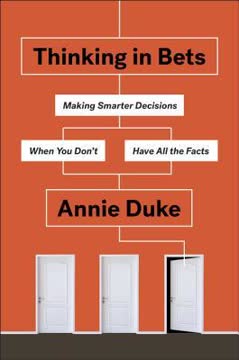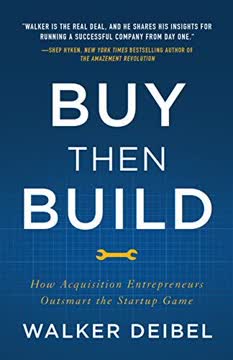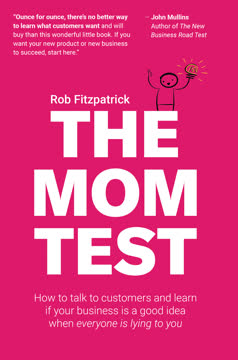Key Takeaways
1. Subscribers are more valuable than one-time customers
Subscribers are better than customers.
Recurring revenue. Subscription businesses generate predictable, ongoing income streams, making them more valuable and stable than traditional one-time sale models. This predictability allows for better planning, smoother cash flow, and increased company valuation.
Customer lifetime value. Subscribers typically have a higher lifetime value than one-time customers. For example, a flower shop selling a $29 bouquet once might make $4,524 from the same customer over three years with a subscription model. This long-term relationship also provides opportunities for upselling and cross-selling.
Data and insights. Subscription models offer continuous customer interaction, providing valuable data on preferences and behaviors. This information can be used to improve products, tailor marketing efforts, and develop new offerings.
2. Nine subscription business models to choose from
The subscription business model has gone mainstream, and people are demanding that their subscriptions offer better value than the alternative.
Diverse applications. The book outlines nine distinct subscription models that can be applied across various industries:
- Membership website
- All-you-can-eat library
- Private club
- Front-of-the-line
- Consumables
- Surprise box
- Simplifier
- Network
- Peace-of-mind
Flexibility and adaptation. These models can be adapted or combined to suit different businesses and customer needs. For example, a company might start with a consumables model and later add a surprise box element to increase customer engagement.
Value proposition. Regardless of the model chosen, successful subscription businesses focus on providing ongoing value to customers, often offering convenience, cost savings, or exclusive access to products or services.
3. The membership website model: Monetizing expertise
When it comes to their livelihood, people are much more willing to pull out their credit card.
Knowledge as a product. The membership website model allows experts to monetize their specialized knowledge by providing subscribers with access to exclusive content, tutorials, or advice. This model works particularly well for niche topics or professional development areas.
Building trust. Successful membership websites often start by offering free content to build an audience and establish credibility. Once trust is established, a portion of the audience can be converted into paying subscribers.
Multiple revenue streams. Many membership websites use their subscription base as a platform to sell additional products or services, such as conferences, coaching, or courses. This multi-faceted approach can significantly increase the overall value of the business.
4. The all-you-can-eat library model: Unlimited access
It was never about the $79, it was really about changing people's mentality so they wouldn't shop anywhere else.
Comprehensive offerings. The all-you-can-eat library model provides subscribers with unlimited access to a large collection of content or products for a fixed fee. Examples include streaming services like Netflix or Spotify, and research databases like Ancestry.com.
Customer lock-in. By offering a vast array of options, this model encourages customers to rely solely on the subscription service for their needs, reducing the likelihood of them seeking alternatives. This creates a strong barrier to exit and increases customer lifetime value.
Content acquisition strategies. Successful all-you-can-eat library businesses must balance the cost of acquiring and maintaining a large content library with subscription pricing. Some strategies include:
- Partnering with content creators
- Developing original content
- Leveraging user-generated content
- Aggregating publicly available information
5. The private club model: Exclusivity sells
When there is more demand than supply, everyone wants to buy.
Scarcity and status. The private club model leverages exclusivity and limited access to create perceived value. This can apply to physical spaces (like golf clubs) or digital communities (like exclusive online forums).
High-value networking. A key selling point of private club subscriptions is often the opportunity to connect with other successful or influential members. This peer-to-peer value proposition can justify premium pricing.
Tiered access. Many private club models offer different levels of membership, allowing for:
- Upselling opportunities
- Aspirational goals for lower-tier members
- Maintenance of exclusivity at higher tiers
6. The front-of-the-line model: Prioritizing customers
To use this subscription model, it's important that you already have a good reputation for baseline service.
Premium service tiers. The front-of-the-line model offers subscribers priority access or enhanced service levels for a fee. This can include faster response times, dedicated support channels, or exclusive features.
Value perception. This model works best when there's a clear distinction between standard and premium service levels. Customers must perceive the upgraded service as significantly more valuable to justify the additional cost.
Implementation strategies:
- Dedicated support teams for subscribers
- Faster processing or shipping for priority customers
- Exclusive access to new features or products
- VIP treatment at physical locations or events
7. The consumables model: Automating replenishment
The guys who are going to be around in ten years are not just hawking other people's products. The companies that will survive have two things in common: they care deeply about the product, and they are focused on building a brand.
Convenience and reliability. The consumables model automates the replenishment of frequently used products, saving customers time and mental energy. This can apply to a wide range of items, from razor blades to pet food.
Brand building. Successful consumables subscription businesses focus on creating a strong brand identity to differentiate themselves from competitors and justify ongoing loyalty. This often involves:
- High-quality, branded packaging
- Personalized customer experiences
- Unique product formulations or selections
- Strong customer service and community building
Challenges. The main challenge for consumables subscription businesses is competition from large e-commerce platforms like Amazon. To succeed, companies must offer unique value propositions, superior products, or build strong emotional connections with customers.
8. The surprise box model: Curating delight
A big part of the reason people subscribe is the joy of finding something new.
Curation and discovery. The surprise box model offers subscribers a curated selection of products on a regular basis. This model capitalizes on the excitement of discovery and the trust customers place in the curator's expertise.
Personalization. Successful surprise box businesses often use customer data to tailor selections, increasing satisfaction and reducing churn. This can involve:
- Preference surveys
- Feedback on previous boxes
- Purchase history analysis
- Algorithmic recommendations
Marketing opportunities. Surprise boxes can serve as a marketing channel for brands, allowing them to introduce new products to targeted audiences. This can create additional revenue streams through partnerships or sponsored inclusions.
9. The simplifier model: Reducing cognitive load
The owner wants to return from work, put their feet up, and simply enjoy their home without the hassles of a daily to-do list.
Outsourcing tedious tasks. The simplifier model takes recurring tasks off customers' plates, reducing their cognitive load and freeing up time and mental energy. This can range from home maintenance services to personal shopping.
Targeting busy professionals. This model often appeals to time-poor, cash-rich customers who value their leisure time more than the cost of the service. Successful simplifier businesses focus on:
- Seamless, frictionless experiences
- High reliability and consistency
- Clear communication and transparency
- Customization to individual needs
Building trust. As simplifier services often involve access to personal spaces or information, building and maintaining trust is crucial. This can be achieved through:
- Rigorous employee screening and training
- Strong privacy and security measures
- Consistent, high-quality service delivery
- Open communication and problem resolution
10. The network model: Leveraging user growth
The utility of the subscription increases as more people subscribe.
Network effects. The network model relies on the principle that the service becomes more valuable as more users join. Examples include communication platforms like WhatsApp or professional networks like LinkedIn.
User acquisition strategies. Network model businesses often focus on rapid user growth, sometimes prioritizing this over immediate monetization. Strategies can include:
- Freemium models
- Referral incentives
- Integration with existing networks or platforms
- Strategic partnerships
Monetization challenges. Once a critical mass of users is achieved, network model businesses must carefully balance monetization efforts with maintaining user growth and engagement. This often involves introducing premium features or tiered pricing structures.
11. The peace-of-mind model: Selling security
It's the best damn business model in the world . . . it's got great predictability for planning, which helps you as an entrepreneur sleep at night.
Emotional value. The peace-of-mind model sells security and reassurance, often for high-value or irreplaceable items. This can include insurance-like services or monitoring systems.
Proactive vs. reactive. Successful peace-of-mind businesses often focus on proactive measures and prevention, rather than just reactive services. This can increase perceived value and reduce the cost of fulfilling the service promise.
Pricing strategies:
- Risk-based pricing
- Tiered coverage levels
- Bundle discounts for multiple services
- Long-term commitments for reduced rates
12. Building and scaling a subscription business
CAC Payback Period of under 6 months means you should invest more money immediately and step on the gas.
Key metrics. Successful subscription businesses focus on specific metrics to guide growth:
- Customer Acquisition Cost (CAC)
- Lifetime Value (LTV)
- Monthly Recurring Revenue (MRR)
- Churn rate
Reducing churn. Minimizing customer attrition is crucial for sustainable growth. Strategies include:
- Strong onboarding processes
- Regular engagement and communication
- Continuous value delivery
- Proactive customer service
Scaling challenges. As subscription businesses grow, they must navigate challenges such as:
- Maintaining service quality at scale
- Managing increased customer support demands
- Evolving technology infrastructure
- Balancing growth with profitability
By focusing on these key metrics and addressing scaling challenges proactively, subscription businesses can build sustainable, profitable models that provide ongoing value to customers and stakeholders alike.
Last updated:
FAQ
What's "The Automatic Customer" about?
- Focus on Subscription Models: "The Automatic Customer" by John Warrillow explores how businesses can create recurring revenue through subscription models across various industries.
- Nine Subscription Models: The book details nine different subscription models, providing examples and insights into how they can be applied to different business types.
- Building Recurring Revenue: It emphasizes the importance of recurring revenue for increasing business value and reducing stress for business owners.
- Practical Guidance: Warrillow offers practical advice on transitioning to a subscription model, including overcoming challenges and optimizing business operations.
Why should I read "The Automatic Customer"?
- Understand Subscription Economy: The book provides a comprehensive understanding of the subscription economy and its growing importance in modern business.
- Increase Business Value: It offers strategies to increase the value of your business by implementing subscription models, which can lead to higher valuations and more predictable revenue streams.
- Diverse Industry Applications: Warrillow demonstrates how subscription models can be applied to a wide range of industries, not just tech or media.
- Actionable Insights: The book is filled with actionable insights and real-world examples that can help business owners implement subscription models effectively.
What are the key takeaways of "The Automatic Customer"?
- Nine Subscription Models: The book outlines nine distinct subscription models, each with unique applications and benefits.
- Recurring Revenue Benefits: Recurring revenue increases business value, smooths out demand, and reduces stress for business owners.
- Customer Loyalty and Retention: Subscription models can enhance customer loyalty and retention, leading to long-term business success.
- Overcoming Challenges: Warrillow addresses common challenges in adopting subscription models and provides strategies to overcome them.
How does John Warrillow define the subscription economy?
- Growing Trend: Warrillow defines the subscription economy as a growing trend where businesses offer products or services on a recurring basis.
- Diverse Applications: It applies to various industries, from software and media to retail and services, demonstrating its versatility.
- Customer Relationships: The subscription economy focuses on building long-term customer relationships rather than one-time transactions.
- Predictable Revenue: It emphasizes the importance of predictable revenue streams for business stability and growth.
What are the nine subscription models discussed in "The Automatic Customer"?
- Membership Website Model: Offers access to specialized content or expertise behind a paywall.
- All-You-Can-Eat Library Model: Provides unlimited access to a vast library of content or products.
- Private Club Model: Offers exclusive access to rare services or experiences.
- Front-of-the-Line Model: Sells priority access to services or support.
- Consumables Model: Delivers regularly needed products on a subscription basis.
- Surprise Box Model: Sends curated packages of products to subscribers.
- Simplifier Model: Simplifies recurring tasks for customers.
- Network Model: Provides access to a network or community.
- Peace-of-Mind Model: Offers insurance or monitoring services for peace of mind.
How can businesses benefit from recurring revenue according to "The Automatic Customer"?
- Increased Business Value: Recurring revenue streams can significantly increase the valuation of a business.
- Predictable Cash Flow: It provides a more predictable cash flow, reducing financial stress and allowing for better planning.
- Customer Loyalty: Subscription models often lead to higher customer loyalty and retention rates.
- Market Research: Businesses can gain valuable insights into customer preferences and behaviors through subscription data.
What challenges might businesses face when adopting a subscription model, according to John Warrillow?
- Initial Cash Flow Issues: Transitioning to a subscription model may initially reduce cash flow as revenue is spread over time.
- Employee Resistance: Employees may resist changes to traditional business models, requiring effective change management.
- Customer Acquisition Costs: Acquiring subscribers can be costly, and businesses need to manage these costs effectively.
- Churn Management: Managing customer churn is crucial to maintaining a healthy subscription business.
What is the "LTV:CAC ratio" and why is it important in "The Automatic Customer"?
- Definition: The LTV:CAC ratio compares the lifetime value (LTV) of a customer to the cost of acquiring that customer (CAC).
- Viability Indicator: A ratio of at least 3:1 is considered a sign of a viable subscription business.
- Investment Decisions: Investors use this ratio to evaluate the potential success of subscription businesses.
- Focus on Efficiency: It encourages businesses to focus on efficient customer acquisition and retention strategies.
How does "The Automatic Customer" suggest businesses handle customer churn?
- Onboarding Process: A strong onboarding process can reduce churn by ensuring customers quickly see value in the subscription.
- Customer Engagement: Regular communication and engagement with subscribers can help maintain their interest and satisfaction.
- Product Integration: Integrating the subscription service into customers' daily routines can increase stickiness.
- Feedback and Improvement: Continuously gathering feedback and improving the service can address customer concerns and reduce churn.
What role does customer acquisition cost (CAC) play in subscription models, according to John Warrillow?
- Critical Metric: CAC is a critical metric for understanding the cost-effectiveness of acquiring new subscribers.
- Impact on Cash Flow: High CAC can strain cash flow, especially if the payback period is long.
- Efficiency Focus: Businesses should focus on reducing CAC to improve profitability and scalability.
- Sales Strategy: The choice of sales strategy (e.g., field sales, telesales, self-serve) can significantly impact CAC.
What are some real-world examples of businesses successfully using subscription models from "The Automatic Customer"?
- H.Bloom: A flower subscription service that transformed the traditional flower shop model.
- Dollar Shave Club: A razor blade subscription service that disrupted the shaving industry.
- BarkBox: A surprise box subscription for dog owners that capitalized on the humanization of pets trend.
- FreshBooks: A cloud-based accounting software that used subscription revenue to grow without venture capital.
What are the best quotes from "The Automatic Customer" and what do they mean?
- "Subscribers are better than customers." This quote encapsulates the book's central thesis that recurring revenue from subscribers is more valuable than one-time sales.
- "The best damn business model in the world." This quote highlights the author's belief in the superiority of subscription models for business success.
- "Recurring revenue makes your business a lot more valuable, and it also makes your company less stressful to run." This quote emphasizes the dual benefits of increased business value and reduced stress for business owners.
- "The subscription economy has pitted small companies against big ones and suppliers against resellers, and has even made partners into enemies." This quote reflects the competitive dynamics and transformative impact of the subscription economy on traditional business relationships.
Review Summary
The Automatic Customer explores the benefits of subscription-based business models. Readers appreciate the practical advice, real-world examples, and insights into various subscription types. Many find it valuable for understanding customer retention, pricing strategies, and financial metrics specific to subscription businesses. Some criticize the book for being repetitive or outdated, while others praise its relevance across industries. The book is particularly useful for entrepreneurs and marketers looking to implement or improve subscription models in their businesses. Overall, it's considered a solid resource for understanding the subscription economy.
Similar Books










Download PDF
Download EPUB
.epub digital book format is ideal for reading ebooks on phones, tablets, and e-readers.






